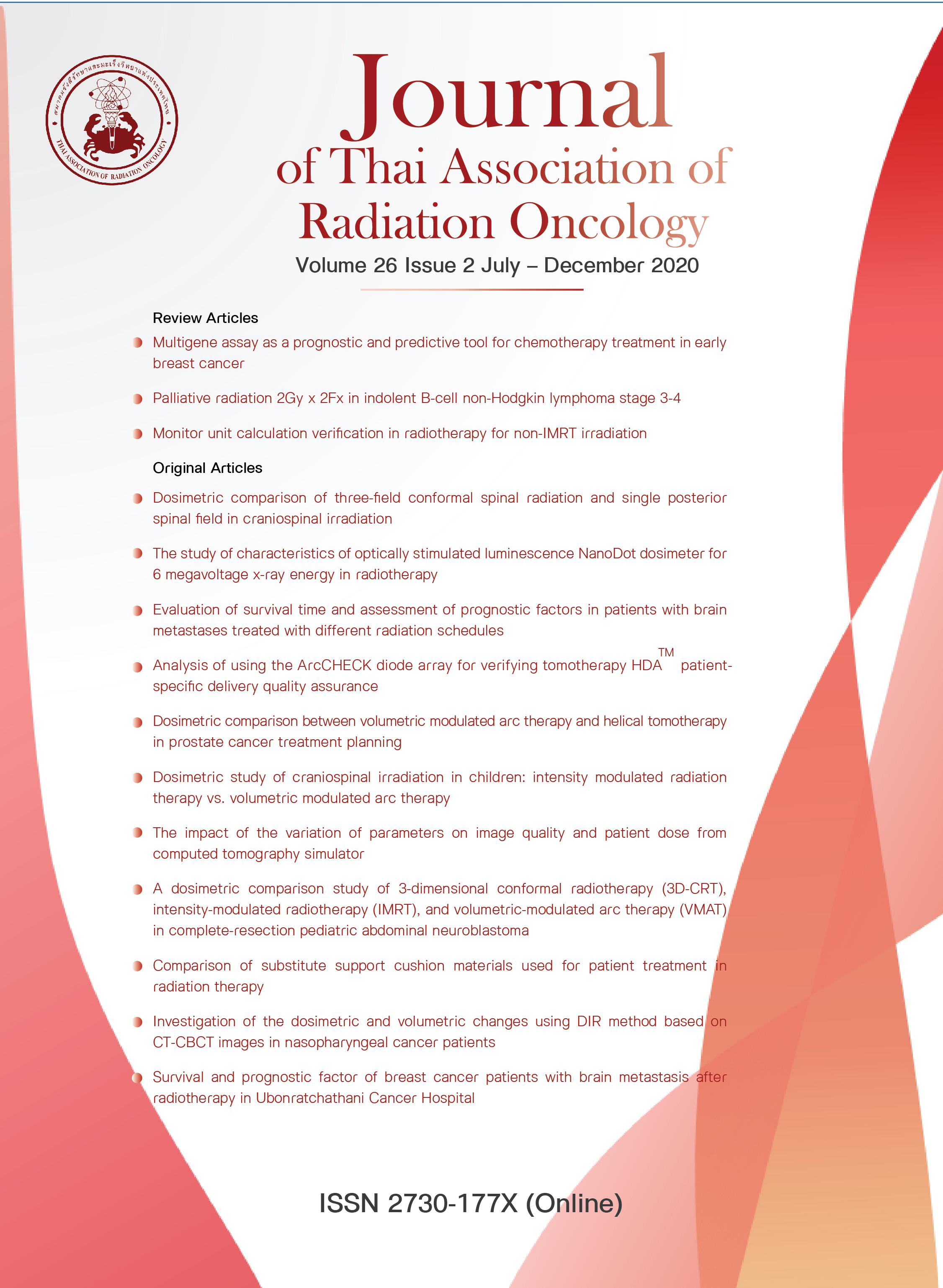The impact of the variation of parameters on image quality and patient dose from computed tomography simulator
Keywords:
Computed Tomography Simulator, Image Quality, Volume Weighted Computed Tomography Dose IndexAbstract
Background: Radiographic images from computed tomography simulator (CT sim) used in radiotherapy should have sufficient quality to be used for cancer treatment planning while the radiation received by the patients should be kept as low as possible. Image quality had an impact on the ability to identify locations of tumor and organs at risk, therefore poor image quality may result in tumor mislocalization and also the efficiency of cancer treatment.
Objective: This study aimed to examine the impact of variation of parameters such as tube voltage, tube current, field of view (FOV) on image quality and patient radiation dose according to the standard criteria of image quality recommended by the American Association of Physicists in Medicine (AAPM) TG 66 to be used as a guideline for radiotherapy.
Materials and Methods: The CATPHAN phantom was scanned by using 36 different CT sim protocols, of which the scanning parameters were changed (80 - 135 kV, 100 - 300 mA and 400 - 700 mm FOV). Quantitative image qualities in terms of the spatial resolution, uniformity, and contrast to noise ratio (CNR) obtained from individual scans were assessed using the RIT software version 6.8.64. Values of volume computed tomography dose index (CTDIvol) were recorded.
Results: The larger FOV, higher tube current and tube voltage resulted in higher CTDIvol. There were five protocols that passed the standard criteria of image quality. These were from the tube voltage settings of 120 kV and 135 kV, tube current settings of 200 mA and 300 mA and FOV setting of 400 mm; as well as tube voltage setting of 135 kV, tube current setting of 300 mA and FOV setting of 550 mm.
Conclusion: Tube voltage, tube current and FOV had an impact on the image quality and patient radiation dose. The protocol recommended by the researcher is the tube voltage setting of 120 kV, tube current setting of 200 mA and FOV setting of 400 mm.
References
Mutic S, Palta JR, Butker EK, Das IJ, Huq MS, Loo LN, et al. Quality assurance for computed-tomography simulators and the computed-tomography-simulation process: report of the AAPM Radiation Therapy Committee Task Group No. 66. Med Phys. 2003;30:2762-92.
ICRU Report 50 Prescribing, recording, and reporting photon beam therapy. [cited 2020 17 march]; Available from: https://doi.org/10.1093/jicru/os26.1.Report50
Nelms BE, Tome WA, Robinson G, Wheeler J. Variations in the contouring of organs at risk: test case from a patient with oropharyngeal cancer. Int J Radiat Oncol. 2012;82:368-78.
Brouwer CL, Steenbakkers RJ, Bourhis J, Budach W, Grau C, Gregoire V, et al. CT-based delineation of organs at risk in the head and neck region: DAHANCA, EORTC, GORTEC, HKNPCSG, NCIC CTG, NCRI, NRG Oncology and TROG consensus guidelines. Radiother Oncol. 2015;117:83-90.
Sanklaa K, Sanghangthum T, Chongsan T. Evaluation of effective doses in CT simulation using CTDIw calculation. J Assoc Med Sci. 2017; 50:417-23.
Davis AT, Palmer AL, Pani S, Nisbet A. Assessment of the variation in CT scanner performance (image quality and Hounsfield units) with scan parameters, for image optimisation in radiotherapy treatment planning. Phys Medica. 2018;45:59-64.
Tomic N, Papaconstadopoulos P, Aldelaijan S, Rajala J, Seuntjens J, Devic S. Image quality for radiotherapy CT simulators with different scanner bore size. Phys Medica. 2018;45:65-71.
Pauwels R, Silkosessak O, Jacobs R, Bogaerts R, Bosmans H, Panmekiate S. A pragmatic approach to determine the optimal kVp in cone beam CT: balancing contrast-to-noise ratio and radiation dose. Dentomaxillofac Rad. 2014;43:20140059.
Catphan500 600 manual. [cited 2019 12 October]; Available from: https://www.uio.no/studier/emner/matnat/fys/nedlagte-emner/FYS4760/h07/Catphan500-600manual.pdf.
Goldman LW. Principles of CT: radiation dose and image quality. J Nucl Med Technol. 2007;35:213-25.
Lindfors N, Lund H, Johansson H, Ekestubbe A. Influence of patient position and other inherent factors on image quality in two different cone beam computed tomography (CBCT) devices. Eur J Radiol Open. 2017;4:132-7.
Downloads
Published
How to Cite
Issue
Section
License
บทความที่ได้รับการตีพิมพ์เป็นลิขสิทธิ์ของวารสารมะเร็งวิวัฒน์ ข้อความที่ปรากฏในบทความแต่ละเรื่องในวารสารวิชาการเล่มนี้เป็นความคิดเห็นส่วนตัวของผู้เขียนแต่ละท่านไม่เกี่ยวข้องกับ และบุคคลากรท่านอื่น ๆ ใน สมาคมฯ แต่อย่างใด ความรับผิดชอบองค์ประกอบทั้งหมดของบทความแต่ละเรื่องเป็นของผู้เขียนแต่ละท่าน หากมีความผิดพลาดใดๆ ผู้เขียนแต่ละท่านจะรับผิดชอบบทความของตนเองแต่ผู้เดียว




